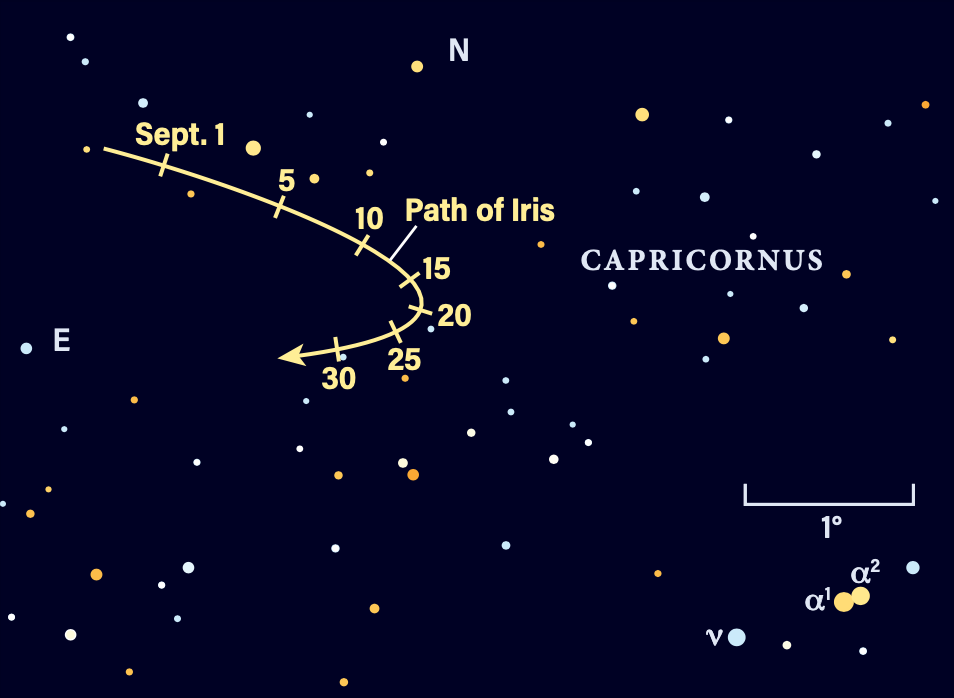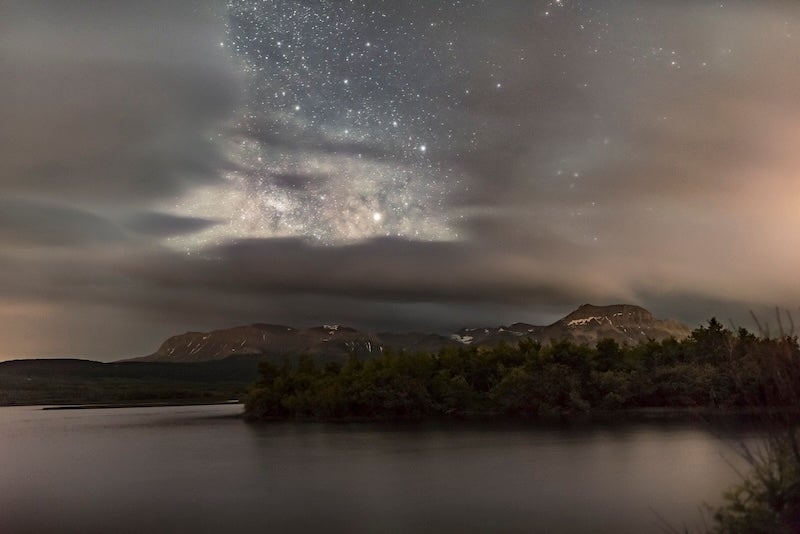
Venus lingers after sunset. Saturn reaches opposition Sept. 8 and Neptune reaches opposition on the 20th. Jupiter dominates Taurus and Mars improves as it passes into Gemini. Mercury makes its best morning appearance in the Northern Hemisphere and the last week of September could offer a naked-eye comet.
Venus is visible in the west for up to an hour after sunset. At magnitude –3.9, it’s easy to spot. On the 4th, a waxing crescent Moon is less than 5° west of Venus. The following evening they switch places, now 7° apart with the Moon southeast of Venus. The pair is still 5° high 30 minutes after sunset.
By mid-September Venus remains quite low after sunset and is 3° from 1st-magnitude Spica — can you spot the star south of Venus, whether with your eye or binoculars? Venus moves into Libra in the last few days of September. It stands 7° high in the western sky 30 minutes after sunset and remains visible for nearly another hour.
Through a telescope, Venus exhibits a 91-percent-lit disk spanning 11″ on the 1st. The phase reaches 85 percent by the 30th, with a slight increase in diameter to 12″.
Saturn is visible all night, rising soon after sunset. It reaches opposition on the 8th. The planet stands 1.5° south of 4th-magnitude Phi (ϕ) Aquarii. Saturn’s retrograde motion carries it westward to a point 3° east of Lambda (λ) Aqr by the end of the month. The planet reaches its peak magnitude for the year, briefly shining at magnitude 0.5 around opposition. At that time, Saturn lies 805 million miles from Earth.
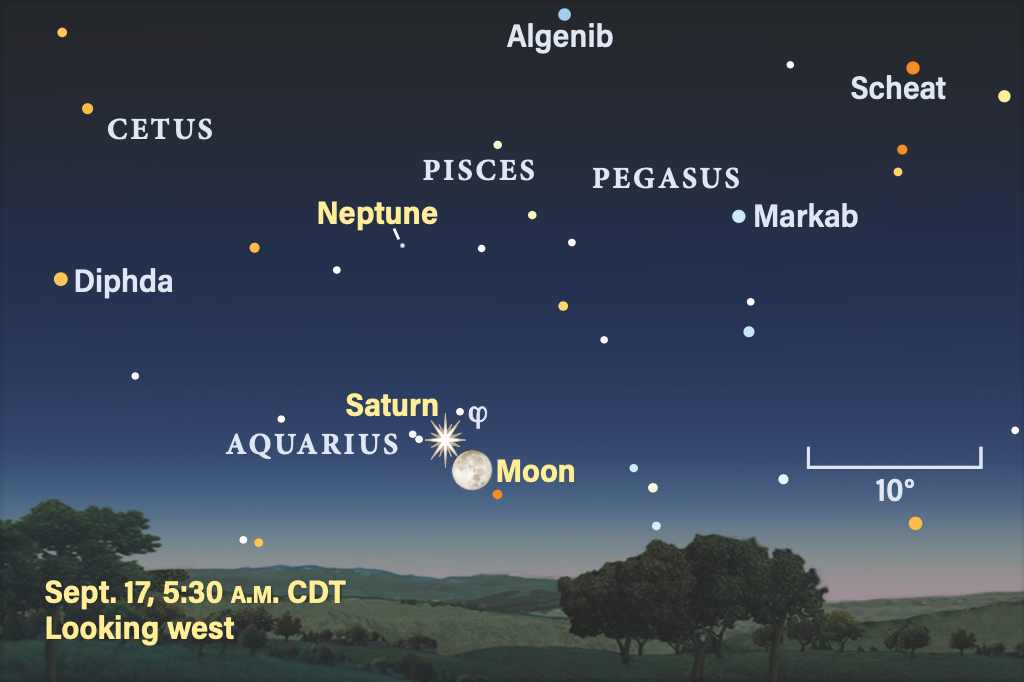
An exciting event occurs the morning of Sept. 17, as Saturn is occulted by the Full Moon from central and western Canada and the U.S. In the Mountain time zone, the event occurs soon after 5 a.m. MDT, with the Moon about 10° above the western horizon. The Moon is 20° high on the West Coast, where the event occurs around 4 a.m. PDT. It takes almost 30 seconds for the disk of Saturn to be covered. The rings will appear very faint against the brilliant Moon. The International Occultation Timing Association’s website lists timing from various cities: www.lunar-occultations.com/iota/planets/planets.htm.
Saturn is stunning through a telescope. Its disk spans 19″. Our viewing angle increases from 3.5° to 4.5° as Earth’s orbit carries us slightly above Saturn’s ring plane. Early next year is the ring-plane crossing; before then, Saturn’s rings reach a peak tilt of just over 5° before declining.
The major axis of the rings now spans 43.5″. Watch for the two evenings on either side of opposition to see if you notice the rings are brighter than normal — exactly at opposition, the ring particles’ shadows are “hidden” from view due to the alignment, resulting in a brightness boost. Known as the Seeliger effect (after German astronomer Hugo von Seeliger), the effect is also enhanced by backscattering of sunlight off the fine particles.
On Sept. 1, the eastern half of the U.S. sees Saturn rise with Titan just a few arcseconds off its southern limb. Titan shines at magnitude 8.4 and orbits in 16 days. It stands near the planet again on the 9th, 17th, and 25th.
On Sept. 2/3, 10th-magnitude Tethys and Dione transit Saturn. The small, faint moons are hard to spot against the bright disk, making this a challenging observation requiring larger telescopes. Alternatively, high-speed video capture under high magnification can record the rare event. In the Mountain time zone, the pair are in transit as Saturn rises. Tethys leaves the disk around 12:20 a.m. EDT (Sept. 3 in the Eastern time zone only), with Dione following just under an hour later.
Iapetus reaches its greatest eastern elongation Sept. 3, when it appears near 12th magnitude. It stands 9.3′ due east of Saturn. The moon then moves toward inferior conjunction early on the 23rd, brightening by a full magnitude. U.S. observers will see Iapetus just 53″ north of Saturn on the evening of the 22nd.
Neptune starts the month just over 12° east of Saturn. It reaches opposition on the 20th, when it stands 2.69 billion miles from Earth. Shining at magnitude 7.7, it’s an easy target when viewing through binoculars. A telescope reveals a 2″-wide disk with a distinctive bluish hue.
Neptune is southeast of the Circlet in Pisces, just a short distance from a parallelogram of four 4th- and 5th-magnitude stars. Neptune stands 3° north-northwest of the northwesternmost star (27 Piscium). The Full Moon passes within 2° of Neptune on the 18th.
Uranus stands 5° southwest of the Pleiades (M45) all month after reaching a stationary point Sept. 1. It rises shortly before 11 p.m. local daylight time on the 1st and two hours earlier by the 30th. The planet’s retrograde motion slowly picks up, carrying it some 20′ west during the month. There’s a nice pair of 6th-magnitude stars, 13 and 14 Tauri, similar in brightness to Uranus (magnitude 5.7) about 4.5° due south of the Pleaides. Uranus is within 1.5° to the pair’s southwest. Through a telescope, Uranus’ disk spans 4″.
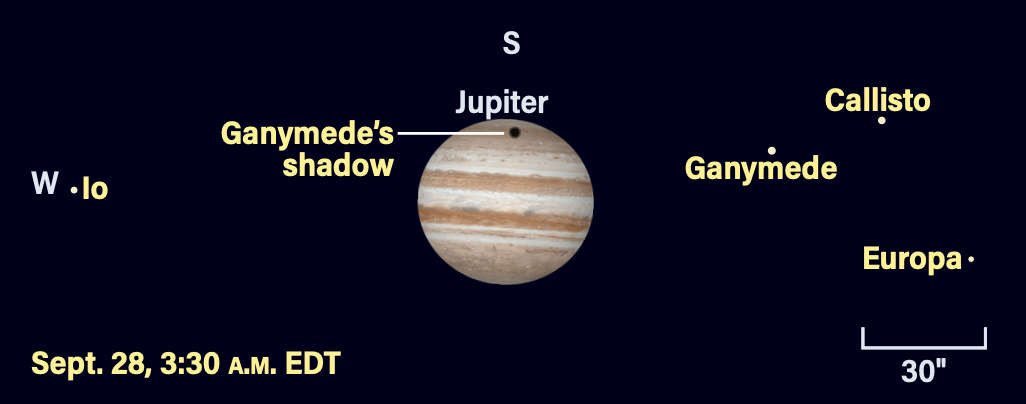
Jupiter is a brilliant object in Taurus, rising around midnight early in the month. The gas giant dazzles at magnitude –2.3 and sits 10° northeast of Aldebaran, Taurus’ brightest star, on the 1st. A 20-day-old Moon joins in on the 23rd and 24th.
The finest views occur when Jupiter is highest above the horizon in the hour before dawn. Telescopes reveal dark bands straddling the equator as well as the four Galilean moons. The disk grows from 39″ on the 1st to 42″ by the end of the month.
Europa transits Jupiter Sept. 1 between about 2:45 a.m. and 5:15 a.m. EDT. The start of the event is only visible from the Mountain time zone eastward. On Sept. 8, Europa’s shadow transits between 2:40 a.m. and 4:08 a.m. EDT. Europa begins a transit about 15 minutes after the shadow transit ends.
Sept. 14/15 finds Io and its shadow transiting as Jupiter rises across the western half of the U.S. The shadow transit begins shortly after 1:10 a.m. EDT on the 15th; Io follows around 2:30 a.m. EDT. The shadow exits at 3:20 a.m. EDT and Io exits at 3:41 a.m. EDT.
Ganymede’s expansive shadow transits for the eastern half of the U.S. on Sept. 20/21. The event is underway as Jupiter rises and ends around 12:45 a.m. EDT on the 21st. On Sept. 27/28, the moon’s huge shadow crosses Jupiter’s south polar region from about 2:45 a.m. to 4:40 a.m. EDT on the 28th. The curvature of the planet is evident in the shadow’s elliptical shape.
Callisto does not transit, due in part to the inclined angle of the plane of its orbit to our line of sight. Instead, it skims near the poles; an example of this occurs overnight on Sept. 19/20.
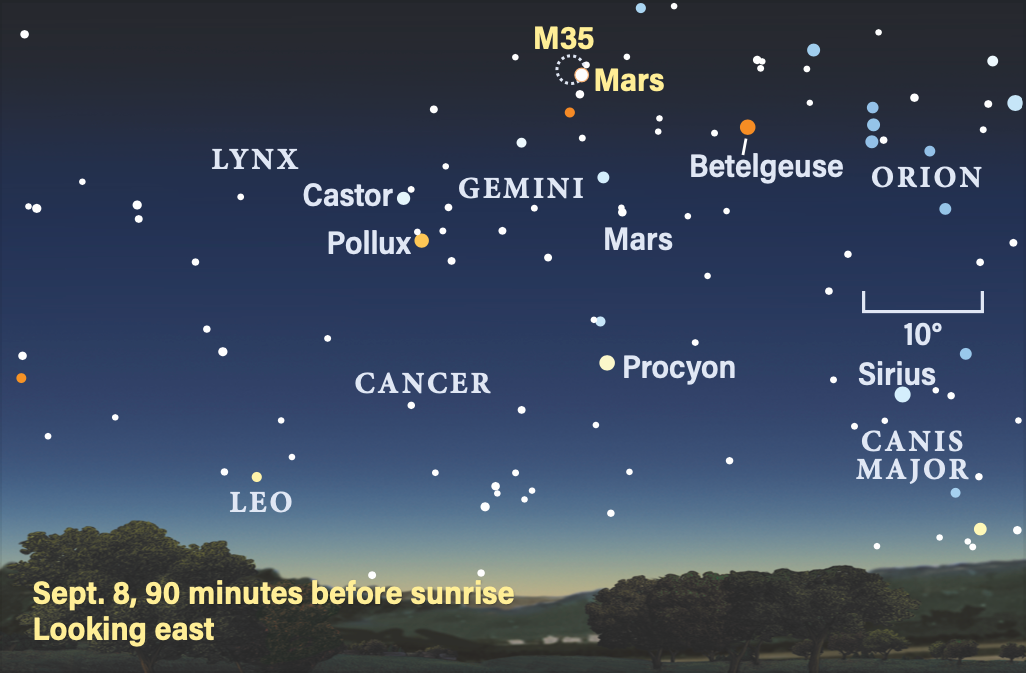
Mars glows at magnitude 0.7 between the horns of Taurus as September opens. It crosses into Gemini on the 6th, when it stands 16° north of Betelgeuse, Orion’s brightest star. Mars rises shortly before 1 a.m. local daylight time on the 1st and about 40 minutes earlier by the 30th. It’s best observed in the pre-dawn hours when it stands high in the sky.
The Red Planet sits 0.9° due south of M35 on the 8th. Three days later (the 11th) it stands 1° due north of Eta (η) Geminorum, then takes three more days to stand 1° due north of Mu (μ) Gem on the 14th. The planet ends the month in the middle of Gemini; at magnitude 0.5 it outshines all the Twins’ stars.
Mars is tiny, spanning just 8″ by the 30th. During the last three months of the year, it will almost double in apparent size as it heads for an early 2025 opposition. The easiest feature to see when Mars is this tiny is dark, delta-shaped Syrtis Major, visible in the pre-dawn hours the first week of September.
September begins with a wonderful crescent Moon adjacent to Mercury in the morning twilight. They are well above the eastern horizon an hour before sunrise. Mercury shines at magnitude 0.5 just over 4° to the lower right (south) of the Moon.
Mercury reaches its greatest elongation west late on Sept. 4. It has brightened to magnitude –0.2 by dawn on Sept. 5. Now is Mercury’s best morning apparition for observers in the Northern Hemisphere.
By the 9th, Mercury stands roughly a Moon’s width (30′) from Regulus and shines at an easy magnitude –0.7, compared with Regulus’ magnitude 1.4. It’s a lovely sight.
Mercury continues brightening, reaching magnitude –1 by the 12th, when it is 5° high in the eastern sky 45 minutes before sunrise. By the 19th you should still be able to follow the planet, now 3° high just 30 minutes before sunrise but magnitude –1.3. Nonetheless, you’ll likely need binoculars to spot it in bright twilight. Mercury quickly dips out of view, heading toward superior conjunction Sept. 30.
But even as the morning sky loses a planet, it gains a comet! C/2023 A3 (Tsuchinshan-ATLAS) climbs in the eastern sky before dawn and stands 14° south of a waning crescent Moon on the 30th. The comet is 5° high in the east about 45 minutes before sunrise. If the comet follows predictions — always a big if — it could be near magnitude 1, perhaps sporting a tail.
A partial lunar eclipse occurs Sept. 17/18, starting at 8:41 p.m. EDT, shortly after moonrise in the Midwest. Most observers across the continental U.S. will see first umbral contact at 10:12 p.m. EDT. Prior to this, if the Moon is up, the duskiness of its northern limb will be apparent in twilight soon after sunset. This is the penumbral shadow, which the Moon entered at the start of the eclipse.
At its peak, the eclipse will cover 8 percent of the Moon for nearly 63 minutes, with maximum eclipse at 10:45 p.m. EDT. It will be visible across the U.S. (except for Alaska), South America, and most of western Europe and western Africa on the morning of the 18th. The eclipse ends at 12:47 a.m. EDT on the 18th.
The autumnal equinox occurs at 8:44 a.m. EDT on Sept. 22 as the Sun, moving along its annual path, dips below the celestial equator.
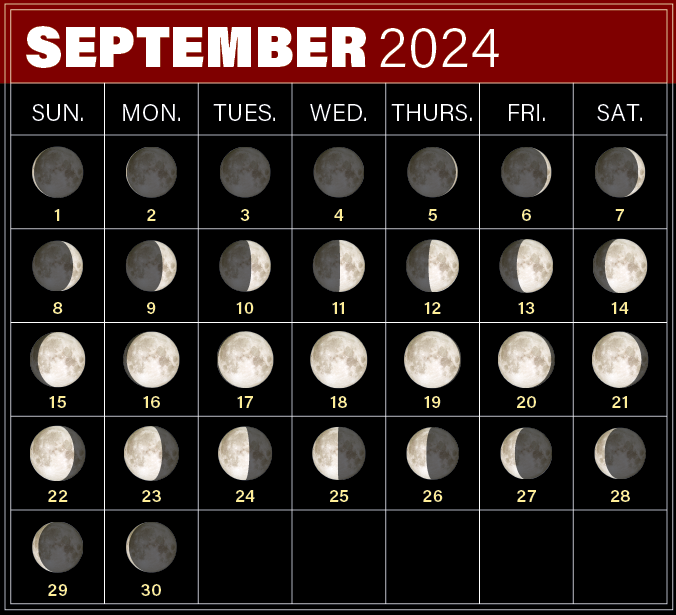
Rising Moon: Double craters and rilles
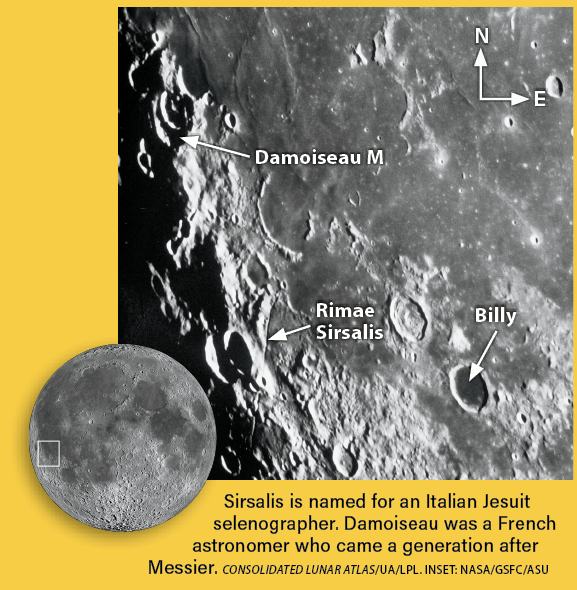
Take advantage of September’s mild evenings to take a break from the deep sky and marvel at the detail along the Moon’s terminator. Once you get past Tycho’s great rays and the bright spot of Aristarchus, zoom in on the lunar southwest. Higher power reduces the brilliance of the moonbeams.
On the 15th, the Sun has illuminated the southwestern shore of Oceanus Procellarum. The smooth-centered crater Billy has one of the darkest floors on the Moon, managing to escape the mottling of multiple lava flows that we can see nearby.
Sitting near the terminator is the fascinating double crater Damoiseau M. The terrain’s complexity is revealed by the low Sun angle — tomorrow night it won’t be quite as impressive. A little more eye-catching just to the south is another double crater. In this pair, the eastern one clearly formed later — it has sharper features and has blown away the other’s rim. More intriguing is the broad rille Rimae Sirsalis, a long, straight valley created by the land pulling apart, possibly due to the Orientale impact still hiding on the western limb. It should still be visible on the 16th, but the shorter shadows are less effective in revealing the depth. If you can, look closely on the 15th and then come back after a couple of hours to see how the lighting has changed.
Meteor Watch: Follow the ecliptic
There are no major meteor showers during September. However, a pre-dawn glow caused by millions of tiny dust particles filling our inner solar system can be observed on clear moonless nights from very dark locations. This zodiacal light shines with similar or a bit fainter brilliance than the Milky Way and is located along the ecliptic, which is angled steeply to the horizon this month, improving your chances of seeing it.
The zodiacal light is a faint cone-shaped glow with a broad base in Leo that narrows higher in the sky through Cancer and Gemini. With a New Moon on the 2nd, the first two weeks of September are the most favorable time this month to view this elusive phenomenon. Any glow from cities to your east will limit the view.
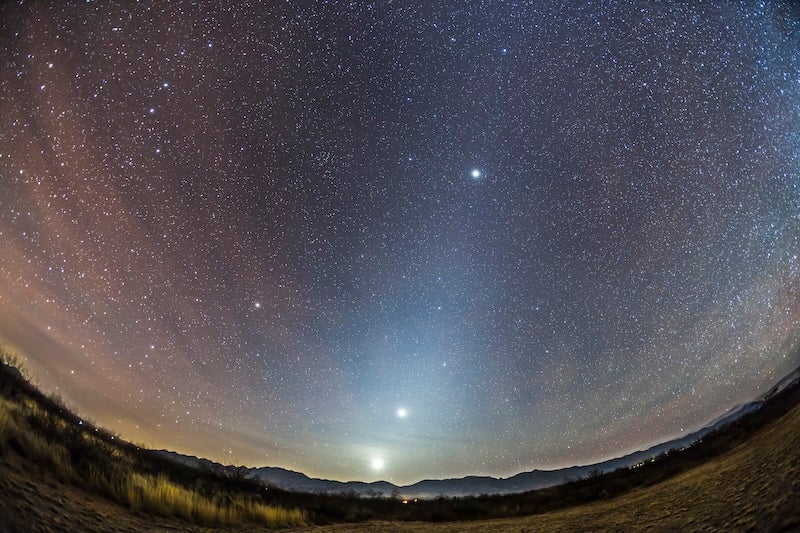
Comet Search: See you next time?
Catch your last looks of Comet 13P/Olbers as darkness sets in. Plan to be away from city lights, set up during twilight, and have a decent northwest horizon. Sinking below 15° in altitude, fuzzballs like this lose contrast as their light attenuates through more of Earth’s atmosphere. You’ll want a 4-inch scope to spy its soft 9th-magnitude glow.
Start at magnitude 4.3 Alpha (α) Comae Berenices, shift north 1° to hit the bright globular star cluster M53, then east another degree to see the fainter NGC 5053. At the start of September, the comet is a bit farther east, but is likely easier to spot than NGC 5053 because that globular is more diffuse. Take time to note their shapes and structures.
Imagers will get a chance to see the coma’s carbon emission shut down. As the comet crosses the orbit of Mars, our Sun just isn’t strong enough to trigger the classic green glow any longer.
Meanwhile, we’re anticipating a super sight in October from the up-and-coming C/2023 A3 (Tsuchinshan–ATLAS).
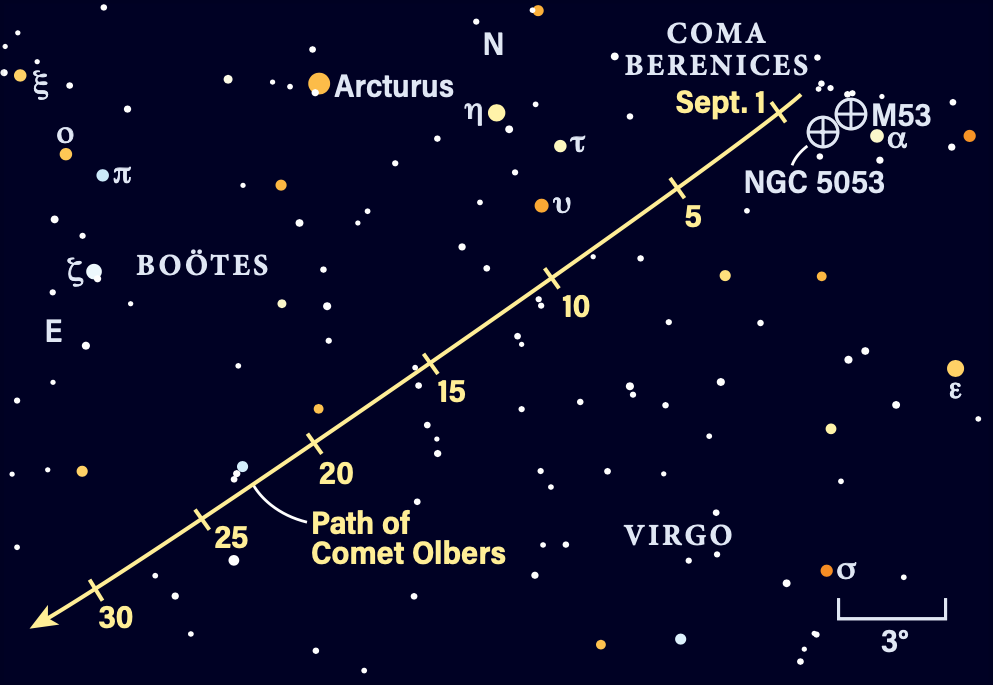
Locating Asteroids: In the clear
7 Iris stands out well from its surroundings this month, making it easy to identify. Not counting a handful of brighter stars, the 9th-magnitude main-belt asteroid outshines the rest of the field except for the last week of the month, when it arcs through a richer field for a masquerade party.
Instead of jumping right to our target, begin at Alpha1 (α1) and Alpha2 (α2) Capricorni, the outstanding pair on the northwestern point of the Sea Goat. Can you split them with the unaided eye? In any scope they are two striking gold stars. Then move northeast to find Iris.
John Russell Hind picked up Iris in 1847, naming it for the Greek rainbow goddess. Like him, compare the view through a small scope to a chart to see which dot doesn’t belong, then return another night to confirm it has moved. The last two weeks of September are particularly good for dropping five dots onto a circle in a logbook and adding Iris once you’ve found it. When the Moon passes by on the 14th, it may not interfere because it is far below the ecliptic, while Iris is above it. When the asteroid reaches perihelion in 2028, it will shine at an easy binocular magnitude of 7.
